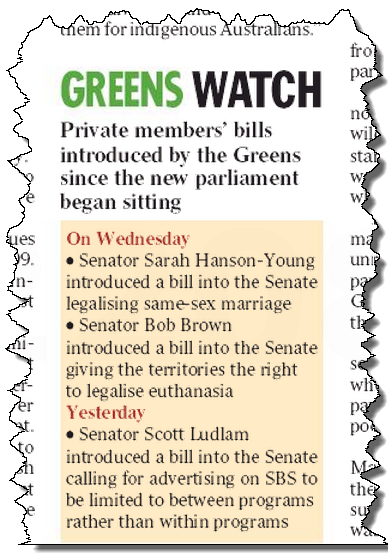Praise be to CALM. They call it the Commercial Advertisement Loudness Mitigation Act, or CALM, and it looks like becoming law in the United States. The US Senate might not be able to agree on many things but this week there was a unanimous vote to on a bill to require television stations and cable companies to keep commercials at the same volume as the programs they interrupt.
The House of Representatives had previously legislated for something similar and the minor differences between the Senate and House versions are expected to be worked out when Congress resumes after the November Congressional elections. This is one piece of legislation where Australia should follow the example of its great and powerful ally or is our television industry too powerful?
Helping the Greens. I’m sure it is not the intent but The Australian is doing a good job in building support for those evil Greens. The national daily has taken to running what it calls “Greens Watch” listing the private members’ bills introduced by party members

In my opinion this current list, far from being the the assortment of mad proposals The Australian has been anticipating, would have a lot of public support.
The power of an advertiser. The Physicians Committee for Responsible Medicine (PCRM), a nonprofit American organization that promotes preventive medicine, conducts clinical research, and encourages higher standards for ethics and effectiveness in research, is having a bit of difficulty in getting a television commercial shown in southern Florida.
That’s the kind of thing that happens when you depict an overweight man lying in a morgue holding a half-eaten hamburger, with a woman crying over his body. The McDonald’s golden arch logo appears over his pale feet with the words “i was lovin’ it.”
It’s not the kind of thing that one of the world’s biggest television advertisers approves of and the stations clearly know it.
A pokies solution. I’m not a regular poker machine player myself but I have been known to while away half an hour when waiting for someone to arrive at the pub. Putting $20 through a machine stops me drinking too quickly and is a small price to pay for such a sensible diversion. The only thing that really annoys me is when I knock off my dollars too quickly and get tempted to go around again with another twenty. I guess it’s temptation something like that which is the real danger for the few who are really addicted to pushing the buttons.
Now our federal politicians are to examine ways of limiting the damage these unfortunates can do to themselves and all kinds of schemes are coming out of the woodwork that seem very Big Brotherish to me. So why not just change the rules so that the machine bandits cannot take a punter’s money so quickly? Change the payout ratio from the often thieving level below 90 percent to something in the high 90s and time itself will work on the side of prevention.
A Liberal Democrat decline. I notice with interest that it is the Liberal Democrats in the United Kingdom whose support the opinion polls show has dropped considerably since they entered into the coalition with the Conservative Party. It is the fate of the Australian Democrats all over again when the elected politicians forget the views of the people who voted for them.








Great news on the US Congress’ move to calm tv ads. I also hope it gets taken up in Ozland. The Australian commercials argue that they don’t turn up the volume of their ads, but that the sound is more compressed or some such. Whatever obfuscation they have, their ads *sound* louder and they should be made to stop. Alternatively, I’d be happy to subscribe to ad-free versions of the free to air channels.
I have also often wondered why the pokies solution wasn’t to increase the payout rate. It would not only reduce gamblers’ losses but also reduce licensees’ profits, thus reducing the incentive to have so many of them. I presumed that a good reason for rejecting this option was given in one of those voluminous pokies reports that I haven’t read.
My recollection of electronics 101 from 40 years ago is that televisions, like radios, have for years had circuitry to automatically regulate “volume.” The networks long ago worked out that this circuitry could be circumvented by using sound compression techniques to ensure that out ears were assailed by a much higher level of energy during ad breaks while the volume remained essentially the same. The argument really comes down to real versus perceived “volume.”
Thanx oldsalt.
So maybe the measure should be changed from volume to sound compression.
Just did a quick revision on the subject. (Don’t we love our wiki.) May I recommend the article on ‘Loudness Wars’ which also leads to others at greater depth.